Last updated on June 12th, 2021 at 03:12 pm
- Extended battery versions have great range
- All versions are quite quick and fun to drive
- Good standard equipment level
- Expensive
- Some cheap-feeling internal switches
- Cramped door entry to rear seats
Range (WLTP): 248-379 miles Top Speed: 111 mph 0 to 62: 5.1-6.2 sec Cost/Mile (@14p/kWh): 3.25-3.84p
Introduction
The original Ford Mustang was launched in 1964 and has been hugely successful over its 57 years of production. The 10 million units sold milestone was reached in 2018. But all those cars have been coupes or convertibles, and the vast majority have sported growling V8 engines. So when Ford announced that the latest instalment in the Mustang series would be both electric and an SUV, fans of the brand were naturally at the very least surprised, and many were outright angry. But rather than being a cynical ploy to bastardise a brand for a new venture, there are some valid reasons why the new Mach-E can wear the legendary wild horse logo with pride. As Ford’s first electric-only car (not converted from a petrol or diesel model), it is a very bold move from the company.
Price and Options
There are two main model types of the Mach-E, one with rear wheel drive, and one with all-wheel drive. On top of this, you can choose between two battery sizes, both of which are quite large. There is a 68kWh Standard Range battery, and a large 88kWh Extended Range unit. So that makes four models to choose from, and Ford also has GT and GT Performance versions in the works. You can order these already in the US, but not in the UK until later in 2021.
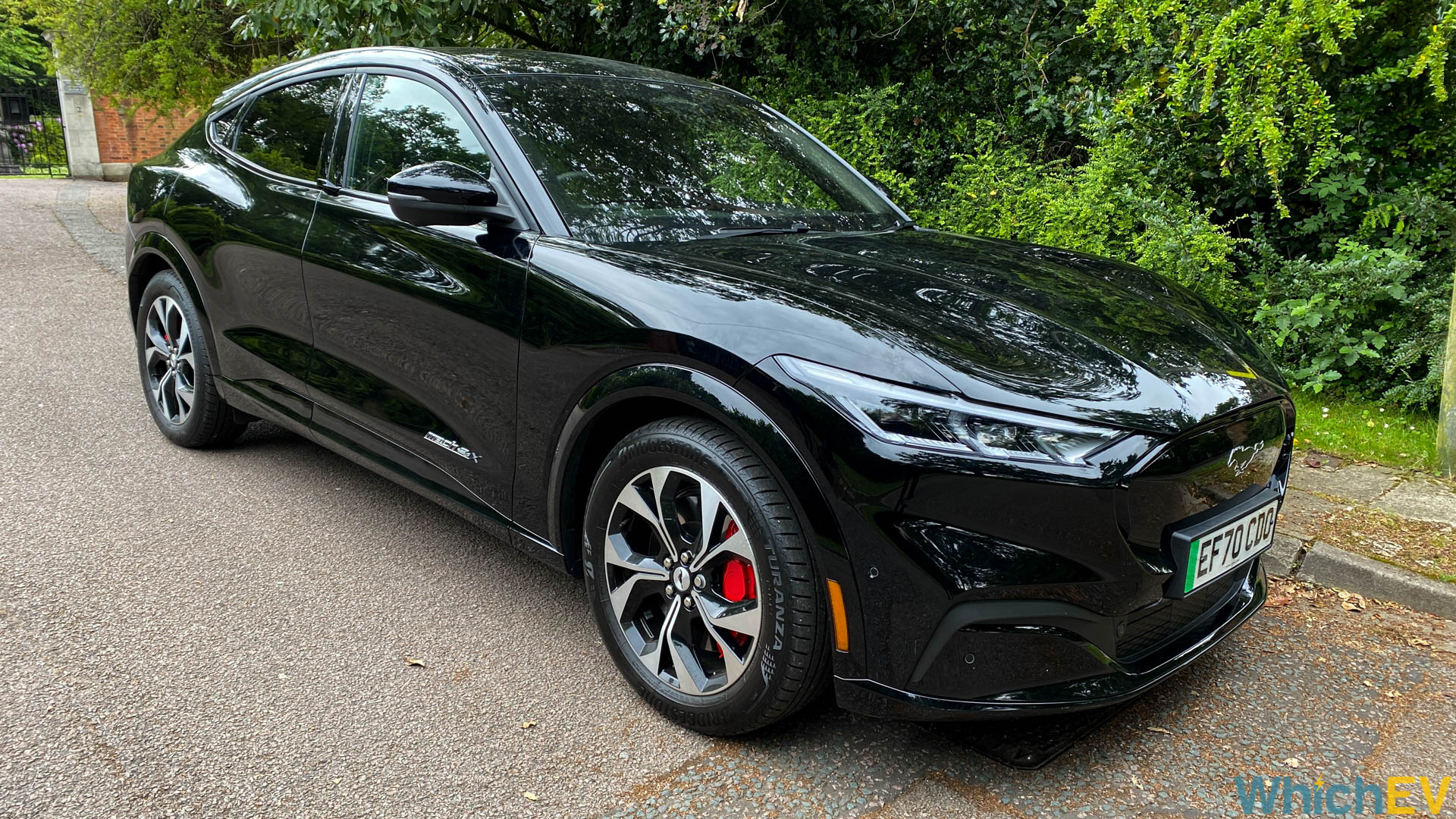
The power figures for the four cars also vary in an unusual way. The RWD cars have 430Nm of torque and the AWD ones 580Nm, but the peak power also seems to vary with battery size. So the Standard Range cars have 269 PS, whereas the Extended Range RWD has 294 PS and the Extended Range AWD 351 PS. So all four cars will have subtly different dynamics. We were provided with the range-topping Extended Range AWD, so our thoughts on driving will be based on this version.
There is quite a variation in prices as well, with the RWD version starting at £41,330, whereas the AWD starts at £46,650. The Extend Range RWD is £49,980, and the Extended Range AWD we drove £57,030, which puts it right up against the Volvo XC40 Recharge AWD and not far off a Tesla Model 3 Performance. That is a lot of money for a Ford, even a Mustang, and we suspect the GT version will go well past £60,000 considering the performance characteristics it promises.
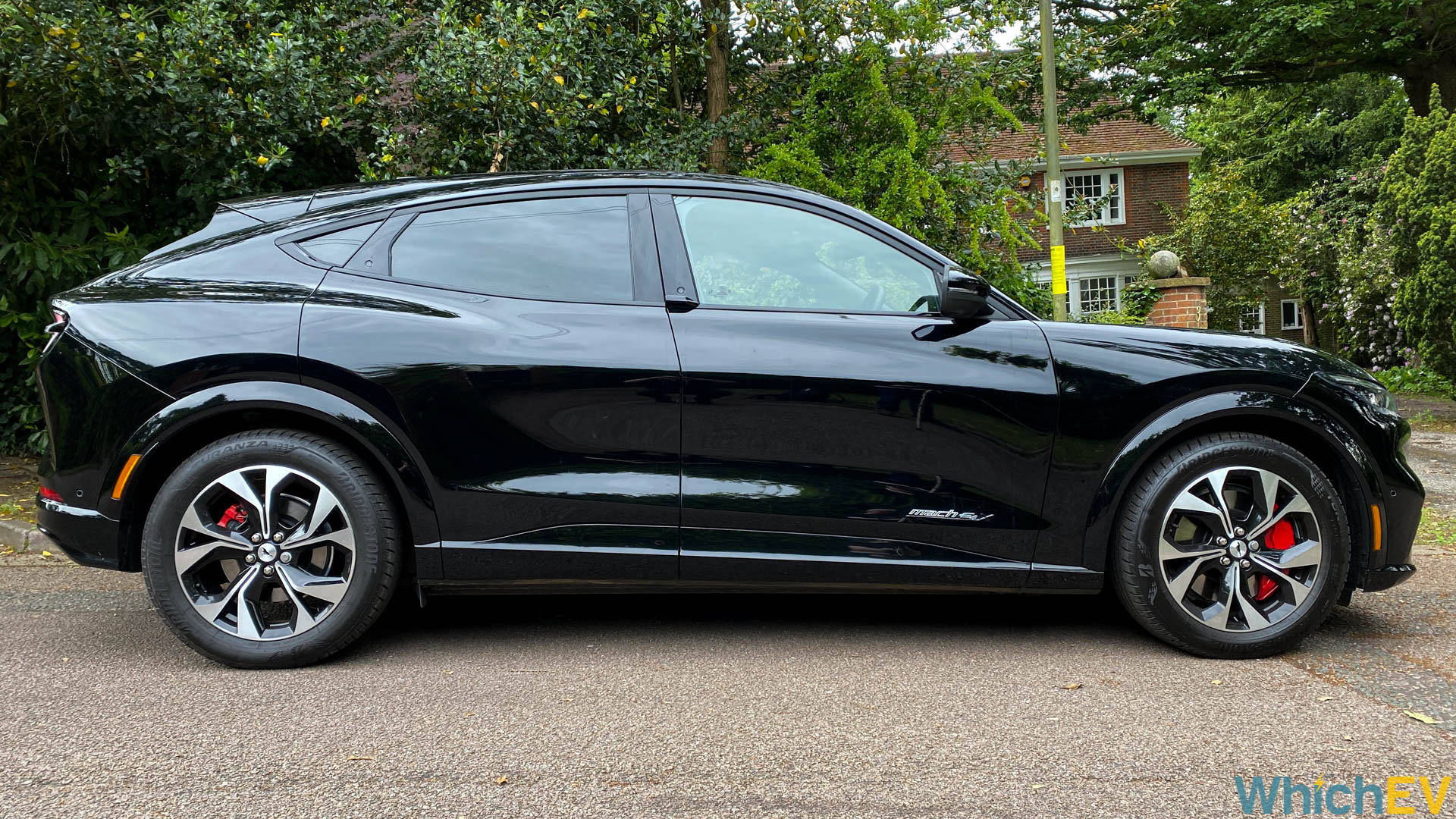
The RWD and AWD versions get some different features, such as 18in alloys with the RWD and 19in ones with the AWD. Even with the 19in rims the tyres aren’t particularly low profile, with a 55% sidewall aspect ratio, which is good for ride quality and will help prevent curbed alloys when parallel parking in a city. You get eye-catching red brake callipers with the AWD cars too. Ford also talks about “unique exterior and interior features” separating the two model lines, without going into much detail about what these are. However, the standard equipment is decent across the board, with all cars including key tech features like wireless phone charging and adaptive cruise control.
The black finish of our review car is the standard paint colour, but you can get a range of silver, white, blue, grey, and red options for between £800 and £1,150. These options are the same across all four cars. There aren't any extra option packs you can choose, but you get different equipment with battery size you choose. The Extended Range cars get the Technology Pack plus, which adds a panoramic sunroof, ten-speaker Bang and Olufsen stereo, hands free boot release, and a 360-degree parking camera.
Exterior Design
Ford is playing on much more than just the Mustang name with the Mach-E. Despite being an SUV, this car has plenty of stylistic cues from the most recent 6th Generation internal combustion engine Mustang coupe. The front is highly reminiscent, except that the radiator air intake grille has been replaced with a plate. The frowning headlights are very similar. The rear also has the characteristic row of three angled lights on each side.
The end result is an attractively curvy appearance, with a sloping fastback that also echoes the coupe sportscar version and has been a feature of the model’s design since its launch in 1964. But this is a much taller car, due to the SUV body shape. It is a more interesting design than most SUVs, and Ford has clearly chosen this for a couple of reasons. Firstly, it is easier to fit bulky high voltage batteries in an SUV body. Secondly, this is the bestselling type of car in both the US and Europe.
All cars get a keyless entry system that has an unusual operation. Assuming you have the keys on your person, you press a round button on any door to unlock. The two front doors have little handles to grab onto to pull them open, although they present themselves to you to help out. The B pillar has a keypad on it with which you can add a greater level of security.
Interior Comfort
Whichever version of the Mustang Mach-E you choose, you get black seats, and they are always made of a material called Sensico, which is another of the increasing number of artificial leather alternatives. The design is slightly different on the two main model types, with just stitching on the RWD, but both stitching and perforation on the AWD. We're not sure about some of the combinations of materials in the rest of the interior, which are all very sustainable but end up looking a bit busy.
Whichever model you get, the seats are heated, and so is the steering wheel. However, with the Extended Range cars, the seats are electronically adjustable with a three-position memory function. The seats are comfortable enough but aren’t quite the level of sports seats. The side bolsters don’t hold you in place as well as, for example, the seats in the Mini Electric. However, the headroom is good, and the seats are easy to adjust to a comfortable position.
There is a decently sized cubby underneath the central armrest, with a couple of cupholders towards the front. Ahead of that is a wireless phone charger, which is a universal feature of all Mustang Mach-Es. The design is a little misleading, because it looks as if there are two spaces like on a Tesla Model 3. However, the right-hand side is smaller and isn’t actually a charger. On the plus side, the left-hand side is large enough for the current largest devices, such as an iPhone 12 Pro Max. There are also Type A and C USB ports.
A nice touch for those infrequent times when we have sun in the UK is the compartment above your head that is designed for holding sunglasses. This is much more convenient than the glove compartment, which is fairly small, although it is enough for a couple of high visibility vests and the documentation for the car.
Strangely for a tall SUV, getting into the rear seats isn’t as easy as it should be, thanks to that sloping back. But once you’re inside, there is loads of head room and knee room. The middle seat is wider than some, and if you only have two rear occupants, the back can be pulled down to create an armrest with two cupholders. The two outer seats have ISOfix points for child car seats, but not the front passenger seat.
The rear passengers also benefit from their own directable air vents and USB charging ports. However, the most obvious feature for rear passengers, with Extended Range battery cars, is the panoramic sunroof. It’s not very obvious when you are in the front seats, but from the rear this full-length glass ceiling provides a stunning view of the sky and an incredible sense of space, which is even more surprising when you consider that you hardly notice it is there from outside. It doesn’t open, however.
Storage and Load Carrying
You always hope for a bit more boot space with an SUV. The sloped fastback does reduce this a bit, but the capacity is reasonable. You get powered opening and closing with all cars, and with the Extended Range models there is a hands-free system as well. You simply kick under the rear of the car with the keys on your person and it opens. In our testing it proved to be one of the more reliable examples of the genre.
As the boot door opens, the cover rises with it in a very neat way, resulting in a reasonable 402 litres of space, enough for a big grocery shop or overnight bags for five occupants. There is a space underneath the boot floor for some emergency items, and you could put charging cables here. But they don’t reside in this space by default, the reason for which we will come to shortly.
If you drop the rear seats forward, which has the typical 60/40 split, you get 1,420 litres, which is about the same as a typical mid-sized estate car. The resulting space is very flat, making even long fragile items like mirrors or artworks safe to transport.
The reason why there aren't any cables in the back is because there is a sizeable frunk that has been designed to store the charging cables neatly and securely. It contains a frame with compartments specifically designed to hold the bags for the Type 2 cable and granny charger. You can remove some plastic lugs and open this up to make a 140-litre space, which is only 31 litres less than the rear boot on the Honda e, for example.
The Mustang’s interior control system is generally quite standard and not futuristic, with one significant exception – the central screen – which we will get to shortly. Otherwise, the steering wheel is traditional in shape with typical buttons for the adaptive cruise control on the left, and for media and phone operations on the right. There are dedicated stalks for lights and indicators on the left, and windscreen wipers on the right. These stalks have a cheap feeling about them, however.
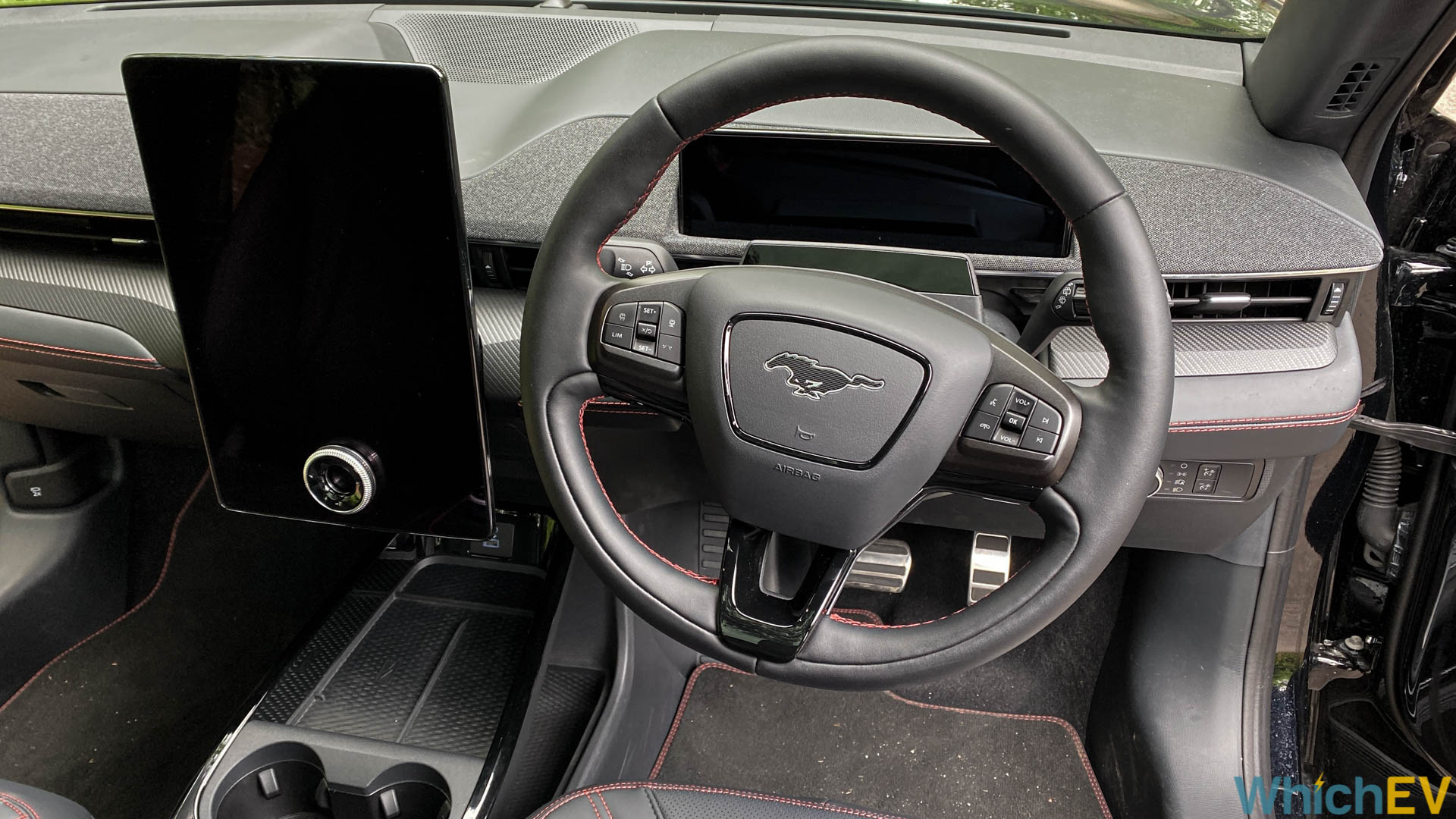
There are a few other less than optimal elements to the general controls, with a driver’s air vent that is hard to adjust as its operations are hidden behind the LCD screen. The buttons for the central locking and unlocking (and seat memory if available) are rather far forward on the door. However, the drive control is intuitive enough, with a large rotating knob used to select drive, reverse, neutral and park. There is also an L button in the middle, which is for selecting extra regeneration when travelling downhill, although if the car is in one-pedal mode this button doesn’t do anything extra.
There is a separate electronic parking brake, but with auto hold engaged you won’t find you have to use it that often. However, there is no separate control for engine power modes. The Mach-E does have these, but only accessible via the LCD, which we will get to shortly. Before we do, we should mention the 10.2in panel behind the steering wheel, which takes a minimalist approach but is effective. On the right is the current speed and icons so you know whether you are in drive, reverse, neutral or park. The central icon showing the car has a block at the front illustrating braking distance, with blue representing enough, orange providing a warning of proximity, and red for dangerously close. The lines either side represent lane departure information, and change to orange when you are getting near the line. The left-hand side shows remaining miles and battery capacity in percentage. One surprising omission is a graphic showing power delivery or recuperation.
Another omission is physical buttons for the air conditioning, but this brings us to that central LCD panel, which is a huge 15.5in unit the same size as used by a Tesla Model 3. This provides touch buttons permanently at the bottom for the climate control, heated seats, and heated steering wheel. The air conditioning has left and right zones, and when you hit the fan or temperature buttons you get big sliders that are easy to adjust when driving, making this much safer to operate than with a Tesla Model 3. There is also a big physical knob at the bottom in the middle for controlling volume on the hi-fi.
Ford has clearly given considerable thought to this central display because it is very intuitive and simple to use. Its size makes the sat-nav screen extremely easy to see and the design is excellent too. Of course, you get a DAB/FM radio and the ability to connect a smartphone via Android Auto or Apple CarPlay. There are two ways to get to menu options, with a quick menu button at the top and a car symbol in the right-hand corner to access all the finer details of the vehicle configuration.
The first settings you see are for those engine power modes we mentioned earlier. None are labelled “eco” – this is a Mustang after all. Instead, you get Active, Whisper and Untamed. These change the way information is displayed as well to fit the mode, but you can’t change power modes while driving – you get a warning when you try. Other highlights we have already mentioned include the ability to toggle single-pedal operation and auto hold, which allow you to avoid the brake pedal a lot of the time when city driving. There are also a myriad of controls for all the safety technologies, although you can’t turn some of them off, such as lane keeping assistance. One novel feature is the ability to turn on a fake engine noise, which may add to your derision at this car but it is fun to see it there as standard.
Performance and Driving
This is a Mustang, so the driving experience is paramount. The good news is that this is a fun car to drive and feels faster than it actually is. You won’t be drifting this SUV tail out around a track (the GT version perhaps), but it still has a fittingly muscular response when you hit the naughty pedal. All versions of the Mach E are quick. The slowest is the RWD Extended Range, and that still only takes 6.2 seconds to reach 62mph. The RWD Standard Range takes 6.1 seconds, the AWD Standard Range 5.6 seconds, and the AWD Extended Range 5.1 seconds.
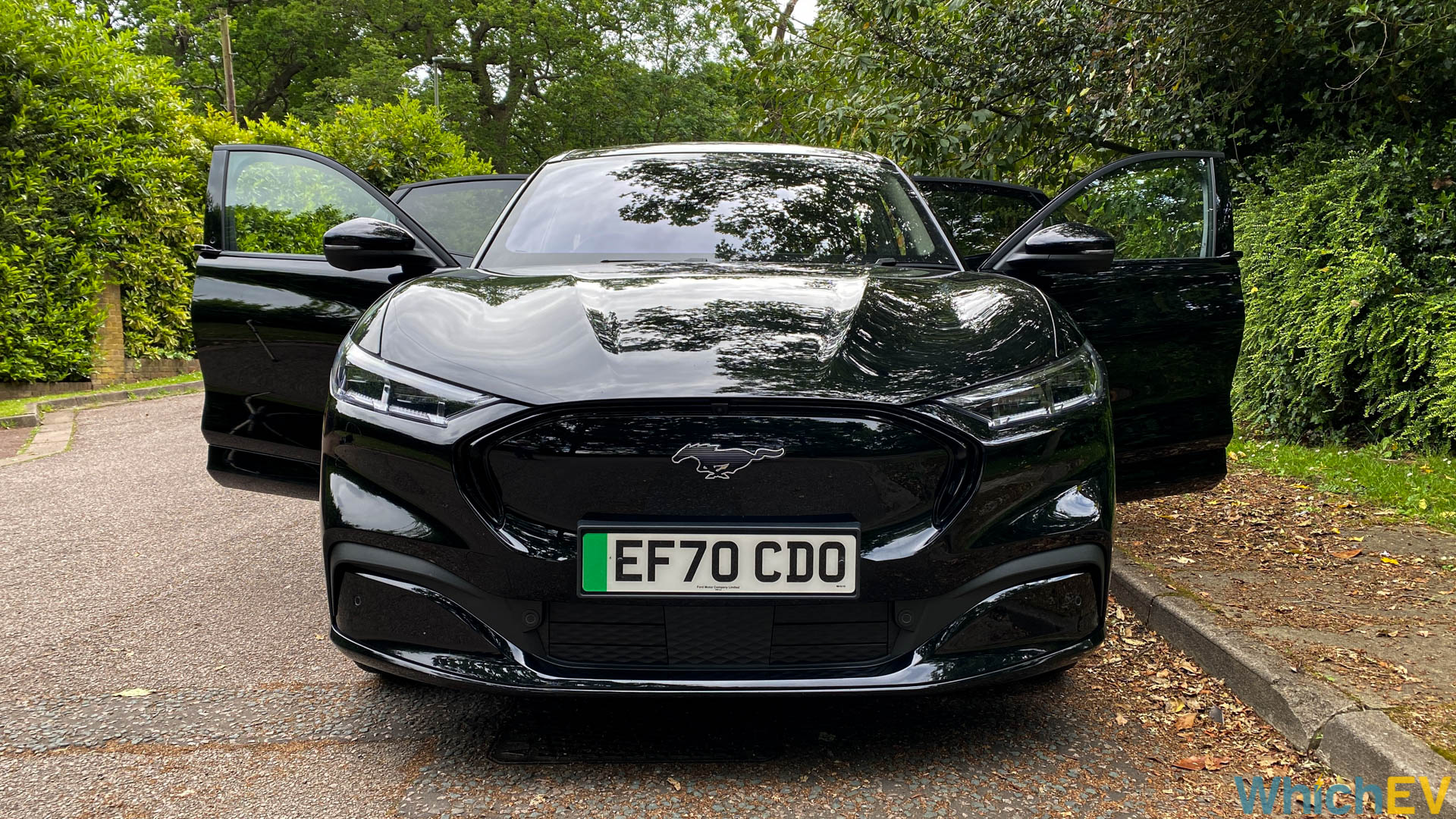
This is still not quite as quick as class leaders in the electric SUV segment, such as the Volvo XC40 Recharge Twin AWD or Jaguar I-Pace. But the AWD Extended Range beats both on range. It is also around the same price as the top XC40 and considerably cheaper than an I-Pace. The Mercedes EQC is about as quick, and also handles slightly better. The Mustang’s handling is good, but the I-Pace is ahead in this area and a Tesla Model 3 will provide much more involvement on a twisty road.
After being somewhat sceptical about that fake engine noise, we have to admit we quite liked it after a while and almost wished it was louder. You do get the urge to hit the accelerator harder to try and hear more noise, which is fun but not a great idea when driving around a city with 20mph speed limits. Overall, the Mach E does provide some of the enjoyment you would expect from a Mustang but can’t escape from the fact that it is a two-ton family SUV.
Range and Charging
Perhaps the biggest revelation with the Mustang Mace E is the range available from most models. The entry-level RWD Standard Range offers 273 miles, which is close to what the Tesla Model 3 Standard Range Plus now offers for similar money. The RWD Extended Range offers a whopping 379 WLTP miles, which is more than a Tesla Model 3 Long Range, again for only slightly more money. It is also much more than any other electric SUV currently available in Europe.
The AWD Extended Range offers 335 miles of range, which is still better than other SUVs and even beats the Volkswagen ID.4, although it is a lot more expensive. The AWD Standard Range is the most limited, with just 248 miles. This car doesn’t seem to have the same clearly unique qualities as the other Mach-E models.
Further aiding the Mach E's distance capabilities, the Standard Range battery gets 115kW DC charging and the Extended Range 150kW, with the latter enabling an 80% charge in just 45 minutes, despite the huge battery. The bigger battery will take over 12 hours to charge on a 7kW AC wall box, where the smaller one will be more like 10 hours.
You also get to use the FordPass card included to facilitate public charging, giving Mustang owners access to around, 9,500 UK charge points, including a year's subscription to bp pulse and IONITY at a cheaper rate than the usual 69p per kW, around 35p instead. Ford was one of the original partners of the IONITY joint venture alongside BMW, Daimler, and Volkswagen, so this is clearly the company’s answer to Tesla’s Supercharger network.
Running Costs
Although the excellent ranges on offer are in large part due to the large batteries, Ford clearly has worked on efficiency as well because the running costs aren’t high for such a potent electric SUV. Even the top AWD Extended Range only costs 3.7p a mile with a 14p per kWh supply, and the most efficient RWD Extended Range drops to 3.25p a mile, which is bordering on the value for a compact electric town car.
The warranty is Ford's usual three years or 60,000 miles, which you can extend to five or eight years with 100,000 miles. The battery has the typical eight-year, 100,000-mile, 70% guarantee we see with most EVs. Insurance groups aren't hideous, either, starting at 33 for the basic car, then 37 for the AWD Standard Range and RWD Standard Range. The AWD Extended Range we tested is in group 40. To put that in perspective, even the entry-level Tesla Model 3 Standard Range Plus is in group 48.
Safety
Despite this car’s performance abilities, it is still essentially a family SUV, and the safety technology available backs that up. Most of this is included across the entire range, too. You get forward collision warning and lane departure warning. The cruise control is adaptive and has lane centring. This isn’t quite as autonomous as Tesla's autopilot, nor the system provided by the Volvo XC40 Recharge Twin AWD, but it will definitely take some of the pain out of motorway average speed zones.

You get blind spot detection with warning symbols on the wing mirrors that flash orange to alert you of a vehicle you may not be able to see, and cross traffic alert for when you're backing out of a space. There is of course automated emergency braking and even some evasive steering assistance. All cars get front and rear parking sensors, but the one additional safety feature that is only on the Extend Range cars is a 360-degree panoramic parking camera. The other cars just get a regular rear parking camera.
| Price: | Standard Range RWD – £41,330; Extended Range RWD – £49,980; Standard Range AWD – £46,650; Extended Range AWD – £57,030 |
| Range (WLTP): | Standard Range RWD – 273 miles; Extended Range RWD – 379 miles; Standard Range AWD – 248 miles; Extended Range AWD – 335 miles |
| Charge time (7.4kW): | Standard Range – 9 hours 15 minutes; Extended Range – 12 hours |
| Charge time (50kW, 80%): | Standard Range – 60 minutes; Extended Range – 90 minutes |
| Charge time (150kW, 80%): | Standard Range – 45 minutes; Extended Range – 45 minutes |
| Battery: | Standard Range – 68kWh; Extended Range – 88kWh |
| On Board Charger: | 11kW |
| Cost per mile*: | Standard Range RWD – 3.49p; Extended Range RWD – 3.25p; Standard Range AWD – 3.84p; Extended Range AWD – 3.68p |
| 0-62mph: | Standard Range RWD – 6.1 seconds; Extended Range RWD – 6.2 seconds; Standard Range AWD – 5.6 seconds; Extended Range AWD – 5.1 seconds |
| Top Speed: | 111mph |
| Power: | Standard Range RWD – 269 PS; Extended Range RWD – 294 PS; Standard Range AWD – 269 PS; Extended Range AWD – 351 PS |
| Wheels driven: | RWD – rear wheel drive; AWD – all wheel drive |
| Cargo: | 402 litres; 1,420 litres with rear seats down |
*based on electricity costs of 14p per kWh






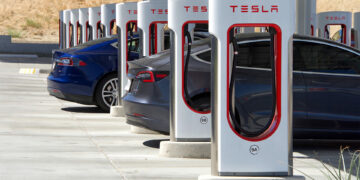

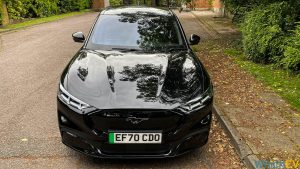




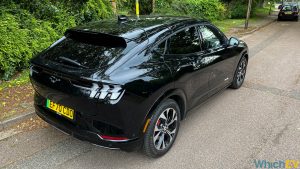

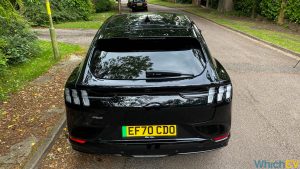
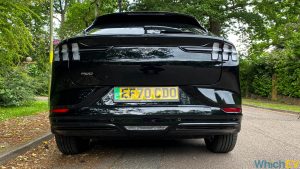
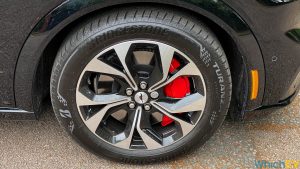
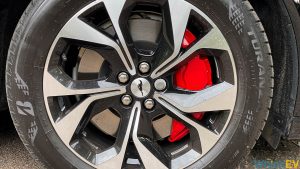
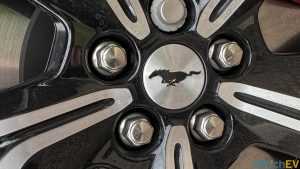
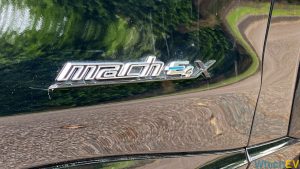

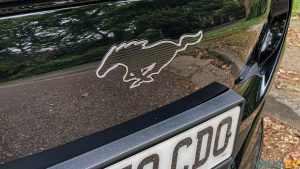


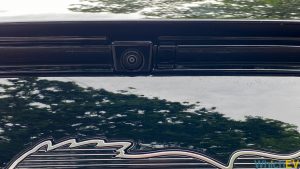





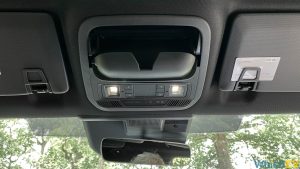
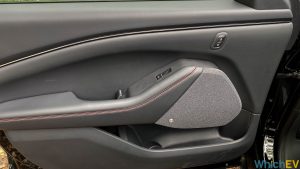
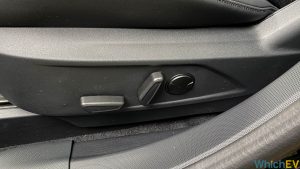
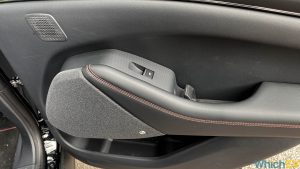
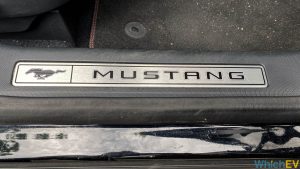

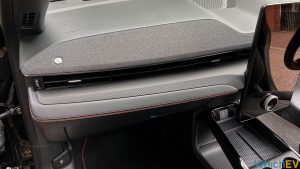

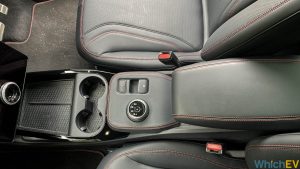
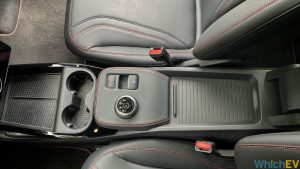
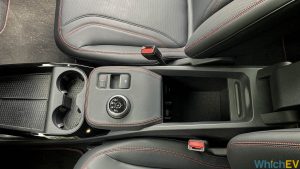

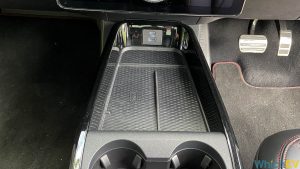

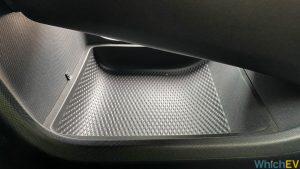
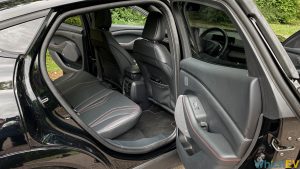
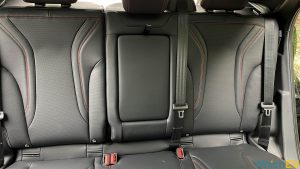


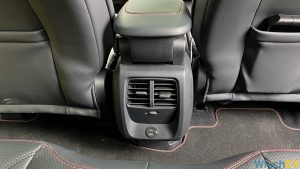


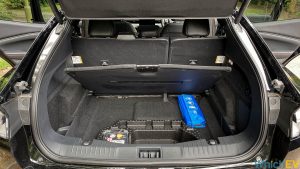
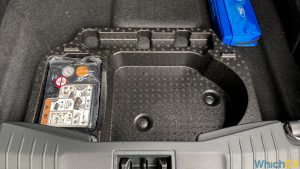
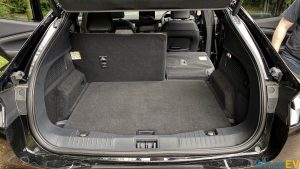
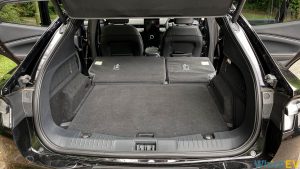
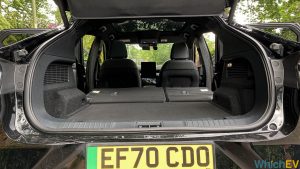


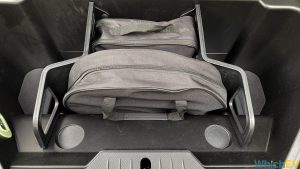
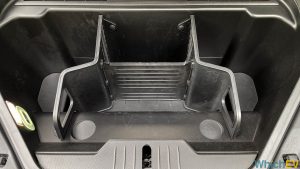
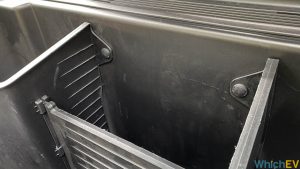

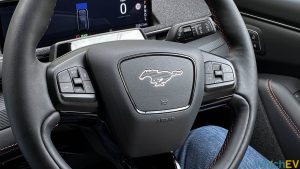
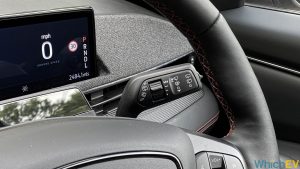
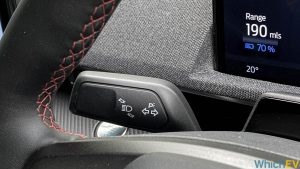


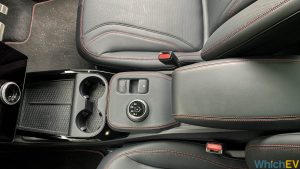
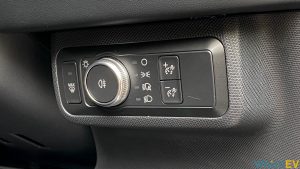
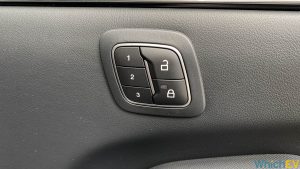



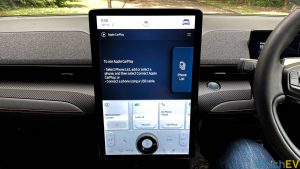





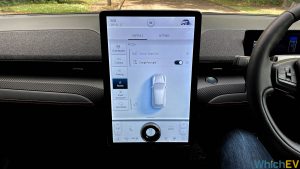
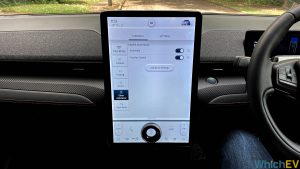
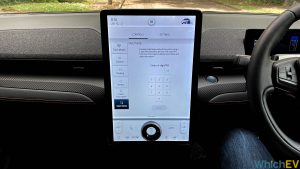
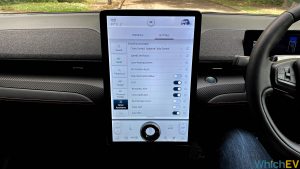


















Discussion about this post